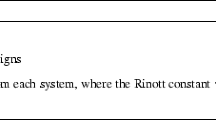Abstract
Particle filtering techniques are a set of powerful and versatile simulation-based methods to perform optimal state estimation in nonlinear non-Gaussian state-space models. If the model includes fixed parameters, a standard technique to perform parameter estimation consists of extending the state with the parameter to transform the problem into an optimal filtering problem. However, this approach requires the use of special particle filtering techniques which suffer from several drawbacks. We consider here an alternative approach combining particle filtering and gradient algorithms to perform batch and recursive maximum likelihood parameter estimation. An original particle method is presented to implement these approaches and their efficiency is assessed through simulation.
Similar content being viewed by others
References
Andrieu, C., De Freitas, J. F. G. and Doucet, A. (1999). Sequential MCMC for Bayesian model selection,Proceedings of the IEEE Workshop on Higher Order Statistics, 130–134.
Benveniste, A., Métivier, M. and Priouret, P. (1990).Adaptive Algorithms and Stochastic Approximation, Springer, New York.
Cérou, F., LeGland, F. and Newton, N. J. (2001). Stochastic particle methods for linear tangent equations,Optimal Control and PDE’s-Innovations and Applications (eds. J. Menaldi, E. Rofman and A. Sulem), 231–240, IOS Press, Amsterdam.
Doucet, A., Godsill, S. J. and Andrieu, C. (2000). On sequential Monte Carlo sampling methods for Bayesian filtering,Statist. Comput.,10, 197–208.
Doucet, A., de Freitas, J. F. G. and Gordon, N. J. (eds.) (2001).Sequential Monte Carlo Methods in Practice, Springer, New York.
Durbin, J. and Koopman, S. J. (2000). Time series analysis of non-Gaussian observations based on state space models from both classical and Bayesian perspectives (with discussion),J. Roy. Statist. Soc. Ser. B,62, 3–56.
Gilks, W. R. and Berzuini, C. (2001). Following a moving target—Monte Carlo inference for dynamic Bayesian models,J. Roy. Statist. Soc. Ser. B,63, 127–146.
Gordon, N. J., Salmond, D. J. and Smith, A. F. M. (1993). Novel approach to nonlinear non-Gaussian Bayesian state estimation,IEE Proceedings F,140, 107–113.
Hayrvey, A. C., Ruiz, E. and Shephard, N. (1994). Multivariate stochastic variance models,Rev. Econom. Stud.,61, 247–264.
Higuchi, T. (1997). Monte Carlo filter using the genetic algorithm operators,J. Statist. Comput. Simulation,59, 1–23.
Higuchi, T. (2001). Evolutionary time series model with parallel computing,Proceedings of the 3rd Japan-US Seminar on Statistical Time Series Analysis, 183–190.
Iba, Y. (2001). Population Monte Carlo algorithms,Transactions of the Japanese Society for Artificial Intelligence,16, 279–286.
Kitagawa, G. (1996). Monte Carlo filter and smoother for non-Gaussian nonlinear state space models,J. Comput. Graph. Statist.,5, 1–25.
Kitagawa, G. (1998). A self-organizing state-space model,J. Amer. Statist. Assoc.,93, 1203–1215.
Kitagawa, G. and Gersch, W. (1996).Smoothness Priors Analysis of Time Series, Lecture Notes in Statist., Vol. 116, Springer, New York.
LeGland, F. and Mevel, L. (1997). Recursive identification in hidden Markov models,Proceedings of 36th IEEE Conference on Decision and Control, 3468–3473.
Liu, J. S. and Chen, R. (1998). Sequential Monte Carlo methods for dynamic systems,J. Amer. Statist. Assoc.,93, 1032–1043.
Liu, J. and West, M. (2001). Combined parameter and state estimation in simulation-based filtering,Sequential Monte Carlo Methods in Practice (eds. A. Doucet, J. F. G. de Freitas and N. J. Gordon), 197–223, Springer, New York.
Ljung, L. and Söderström, T. (1987).Theory and Practice of Recursive Identification, MIT Press, Cambridge, Massachusetts.
Pitt, M. K. and Shephard, N. (1999). Filtering via simulation: Auxiliary particle filter,J. Amer. Statist. Assoc.,94, 590–599.
Tadić, V. B. (2000). Asymptotic analysis of stochastic approximation algorithms under violated Kushner-Clark conditions,Proceedings of 39th IEEE Conference on Decision and Control, 2875–2880.
Tadić, V. B. and Doucet, A. (2002). Exponential forgetting and geometric ergodicity in state space models,Proceedings of 41th IEEE Conference on Decision and Control, 2231–2235.
Author information
Authors and Affiliations
About this article
Cite this article
Doucet, A., Tadić, V.B. Parameter estimation in general state-space models using particle methods. Ann Inst Stat Math 55, 409–422 (2003). https://doi.org/10.1007/BF02530508
Received:
Revised:
Issue Date:
DOI: https://doi.org/10.1007/BF02530508




